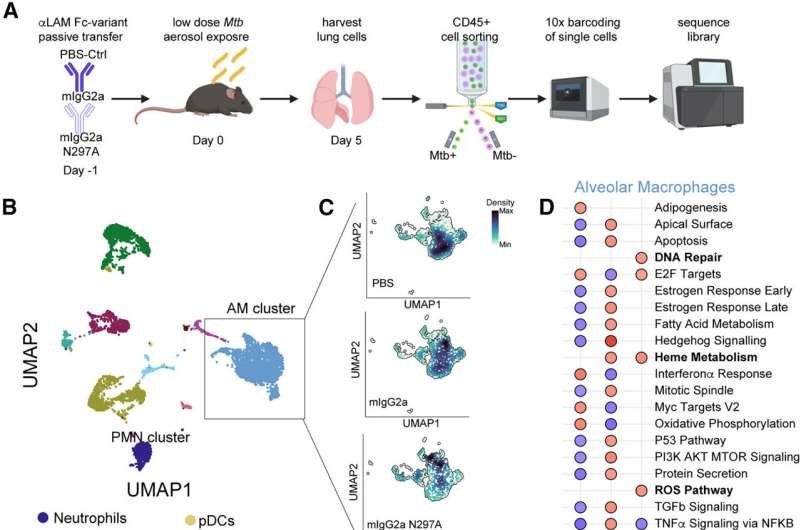
Researchers at the Ragon Institute have made a significant discovery about how antibodies can directly enhance the body’s ability to fight Mycobacterium tuberculosis (Mtb), the bacteria responsible for tuberculosis (TB). Despite decades of research, TB remains one of the deadliest infectious diseases worldwide, with about 10 million new cases and 1.6 million deaths annually. Currently, there is no highly effective vaccine, highlighting the urgent need for new insights and treatments.
In a study published today in Immunity, Ragon faculty member Galit Alter, Ph.D. and previous post-doctoral trainee Patricia Grace, Ph.D., now at University of Pittsburgh, partnered with Bryan Bryson, Ph.D., associate member Sarah Fortune, Ph.D. and a team of collaborators, to collect the largest library of monoclonal antibodies to Mycobacterium tuberculosis (Mtb) the bacteria that causes tuberculosis.
The team identified specific antibody features that significantly limit the growth of Mtb. This research reveals critical new insights into how antibodies interact with immune cells in the lungs to restrict Mtb infection, laying the groundwork for potential antibody-based therapies or vaccines against tuberculosis, both of which are urgently needed.
The team investigated monoclonal antibodies (mAbs), highly specialized antibodies engineered to target specific components of Mtb. They screened a broad library of these antibodies, targeting many different components of the bacteria, to determine which could effectively reduce bacterial growth in infected mice.
They found that particular antibodies targeting different parts of the bacteria—both surface proteins and internal antigens—could effectively restrict Mtb growth, challenging previous assumptions that only antibodies recognizing surface structures could help fight TB.
To better understand the mechanisms behind this antibody-mediated protection, researchers closely examined one particularly effective antibody targeting a molecule called lipoarabinomannan (LAM), found on the bacterial cell surface.
By engineering the antibody constant domain (Fc) to control the killing activities of the antibody, the researchers discovered that maximal bacterial control was achieved when antibodies redirected innate immune cell recruitment and activation. Particularly, antibodies able to redirect the bacteria to neutrophils provided the greatest level of protection.
This discovery highlights a previously unrecognized way antibodies can work against TB not merely by neutralizing pathogens directly, but by reshaping immune cell functions within infected tissues.
Given the rise in antibiotic resistant bacteria, understanding these immune mechanisms opens new avenues for novel therapeutic and vaccine designs that are urgently needed to combat TB. Moreover, this study unlocks future approaches to rapidly discover and design monoclonal therapeutics to a broader array of antibiotic-resistant bacteria in the future.
More information:
Patricia S. Grace et al. Antibody-Fab and -Fc features promote Mycobacterium tuberculosis restriction., Immunity (2025). DOI: 10.1016/j.immuni.2025.05.004. www.cell.com/immunity/fulltext … 1074-7613(25)00225-0
Provided by
Ragon Institute of MGH, MIT and Harvard
Citation:
Antibody-mediated protection mechanism expands tuberculosis treatment options (2025, May 30)
retrieved 30 May 2025
from https://medicalxpress.com/news/2025-05-antibody-mechanism-tuberculosis-treatment-options.html
This document is subject to copyright. Apart from any fair dealing for the purpose of private study or research, no
part may be reproduced without the written permission. The content is provided for information purposes only.

